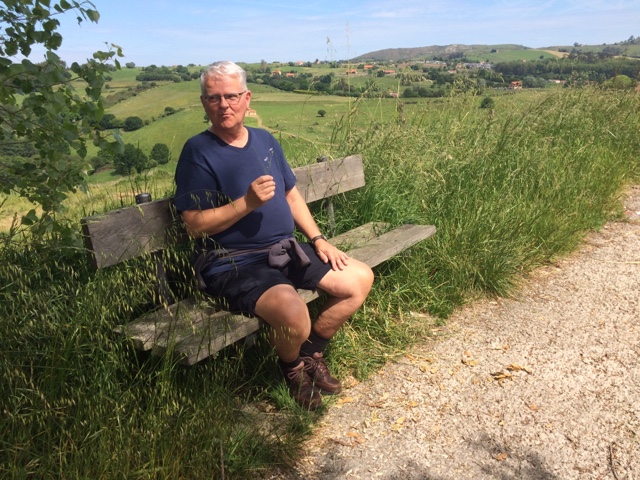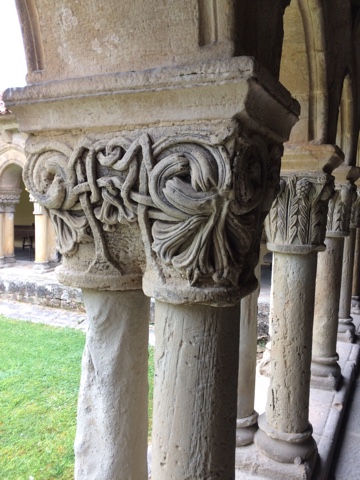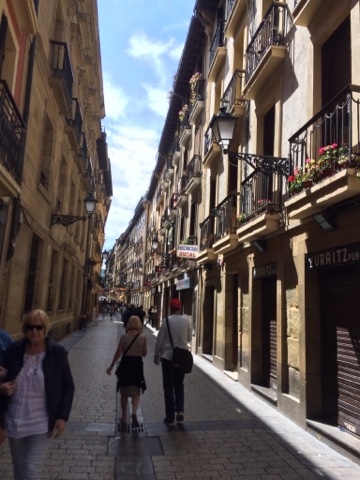Surprise, I'm actually writing my blog post for Santillana the day we moved from it. I readied the pictures last night.
Santillana is an old town with a 12th century church and many old sumptuous buildings which were occupied by the nobility (dukes and duchesses) in its heyday. Many are restored although not open to visitors.
Santillana is also home to one of the most famous caves in the world - the Altamira, which is considered the Sistine Chapel of caves because of its remarkable ceiling paintings, which were painted circa 16000 BCE.
Our first meal was at El Bizonte Rojo (the Red Bison) no doubt named for the bison pictured on the ceilings of the Altamira Cave. While we ate we felt well protected as two of the Guardia Civil were supping a little wine at the bar.
Of course we had the Menu del Dia - here there was a wonderful salad with tomato, goat cheese, walnuts and raisins with a balsamic drizzle and a delicious risotto of bacon and mushrooms - for starters.
The main course was salt cod steaks with clams in a seafood broth.
The old buildings and the cobbled squares and streets were quiet - many of the restaurants were closed for Monday. This is my arty black and white shot of a deserted plaza.
The church of Santa Juliana is from the XII century. The lion at the entrance to the church property is very well worn. Santa Juliana lends her name to the town, but the Ju is elided to achieve Santillana.
In another old property (restored) was the Fundacion Jésus Otero - home of a sculptor who was born and died in the same house here. The sculptures I saw are mostly realistic like this amazing sheep head.
This sculpture was in a different location and I do not believe it is by Otero. But an unusual piece at the entrance to another property.
Told you the streets were deserted.
An entryway to another property.
The town was quite small - here a plaza with the rolling countryside at its doorstep.
The area of Cantabria is known for its cider (sidra) and there were several sidrerias. They have wonderful apparatus which are self serve. Place a tube in the bottle and position it upright. Place the glass at a steep angle into the round support at bottom left, then pump your cider using the vacuum pump at upper right.
Lazing away the afternoon on a very old stone bench.
The church had an interesting frieze above its doorway.
Flowers find root in many of the stone wall crevices.
A night scene of the main street through the village.
And a marvellous balcony which would make a great location for Romeo and Juliet.
We walked the 2 kilometers out of town to the Altamira caves. The countryside is very beautiful and with my new hearing aids I was able to enjoy the wonderful sound of trilling birds.
No photographs were allowed in the cave so I had to make do with this idealized mural in the museum section. The original cave is closed to visitors, as earlier in the 20th century they were badly damaged by both grafitti and the respiration of carbon dioxide by human breathing.
Below are five examples of the art work on the ceiling of the cave. I took photographs of the post cards I purchased at the gift shop. No other comment necessary. Note the paintings have been reproduced with great precision, as have the cracks. All the paintings are on the ceiling so there is much craning of necks.
On the way back, this flower child needed a rest. We had a lovely chat here with four delightful Japanese women who were in Spain for only two weeks.
But we stopped at a posada for coffee further down hill where there were several ponies in the corral next door, including this mother and child.
The roses are in full bloom and gorgeous.
A snail makes its way patiently up a lamp post.
And an old stone bench graces a stone house.
The village is also famous for this - on the left quesada - a solid cheesecake-like square, and sobaos - a small simple cake, served with fresh cow's milk - I think it's actually fresh as in unpasteurized and came from a cow that morning. (There are lots of dairy farms in the immediate area.) The milk is in the round jug with the crocheted cloth over the top. Cost: 1 euro for the milk and cake together.
Look at that wonderfully exuberant woven Celtic knotting.
And this. Such art.
Every pillar was unique, even those with the celtic knotting.
St. George and the dragon perhaps.
In another plaza, a bison - I'm guessing another of Otero's pieces. A sign advises one not to climb the sculpture which didn't stop a 50-something woman from climbing astride it to wave to her friends for her photo op.
A rather low door.
On to San Vicente (we are there now, but it's pouring rain so I'm hoping it will clear so we can get some good pictures tomorrow). Until then.




































































